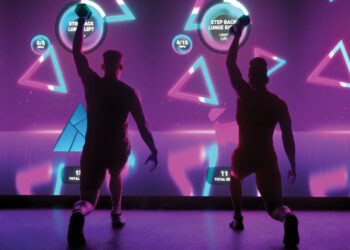The VO2 Max Testing Program is the “bread and butter” of Redkore Fitness, according to founder and president Nadeem Ashraf. The gym uses the program to show members their results over time, which yields higher retention.
The program was invented by NASA to test astronaut’s oxygen intake versus their gas expiration. But the program slid its way into the sports industry to gauge the intensity at which an athlete or member converts fats to sugar or sugar to fats.
“What happens in the main studio is irrelevant if we don’t have correct numbers and data available from our membership base,” said Ashraf. “By producing that result, by keeping the members within [their ideal heart rate] zone, we are able to show them that in a very short period of time, anywhere from 6 weeks to 12 weeks, they start to see a significant change in their body type.”
Because they are able to show their members their results in numbers as well as physical change, Ashraf said Redkore’s attrition rate is less than 8 percent, “which is unheard of in this industry,” he said.
But before any other gym can implement a technology-based retention program, Ashraf said education about the technology and what it’s measuring must come first.
“I think that some big box gyms try to use it, but the problem is they don’t have the depth built in,” explained Ashraf. “What I mean is they don’t have the education built in within their staff to educate their members. So it’s a hit or miss. I think it’s easier for us because we are a small, boutique-style studio.”
An owner also needs to look at the make-up of their gym, in addition to if the staff and culture are based around education and technology-based results. Ashraf said that comes from a hiring standpoint. “I would say the first and foremost important thing is finding that individual that believes in the science, that comes from the background of either exercise science or exercise physiology,” he said.
Once the staff, or a single staff member, understands the technology, he or she needs to be able to explain to the members how numbers (seven data points total for the VO2 Max Test) can help them achieve their goals.
Ashraf believes this type of education and progress can be universal to the entire fitness industry. “The more we work on educating our members instead of giving them what’s been happening 30 years ago … let’s talk about what’s happening currently. What do we have? Believe in it and we have to be on the same base and speak the same language when we talk about creating a culture around how the current science can help us,” said Ashraf.
While he understands certain clubs choose not to adopt technology because of the higher price tag and difficulty in training, he said those things should not stop a health and fitness club from helping or educating members.
“If our members are seeing results, they are not going to leave us. It’s going to help with retention. The cost of acquiring a new membership is far higher than keeping an old member in your system, so that’s what we need to look for,” said Ashraf.









